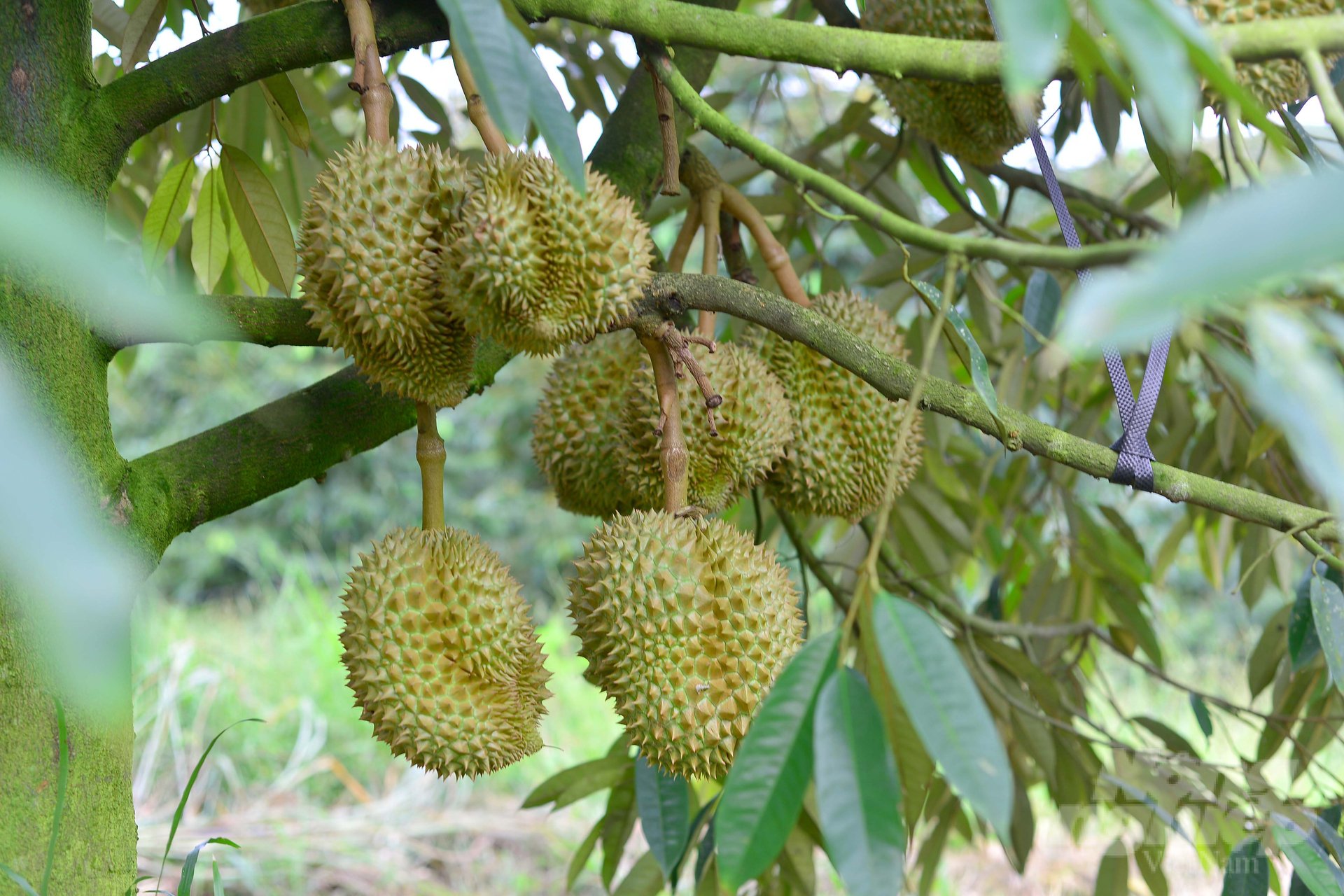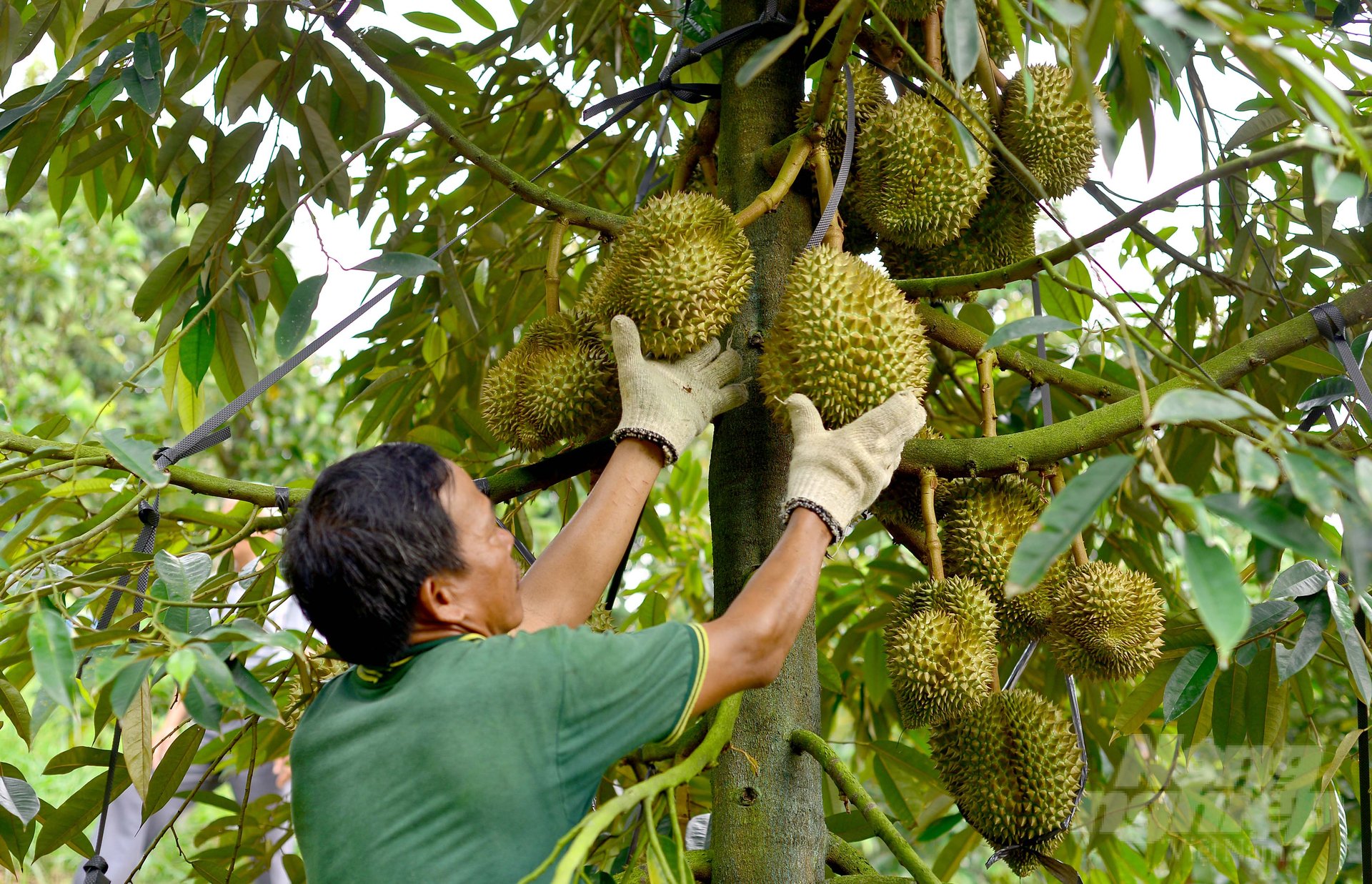November 27, 2025 | 20:49 GMT +7
November 27, 2025 | 20:49 GMT +7
Hotline: 0913.378.918
November 27, 2025 | 20:49 GMT +7
Hotline: 0913.378.918
According to the Office of Agriculture and Rural Development of Dam Rong district (Lam Dong), durian is one of the potential crops and the strength of the district. Recently, the durian production model in the district has been developed with focus, achieving great results.

The area of durian in the whole district of Dam Rong is approximately 1,800 ha. In which, the area of pure cultivation is nearly 750 ha and the intercropping area is over 1,000 ha. Photo: Minh Hau.
"With prices ranging from VND 40,000 to 60,000/kg, durian has become an effective crop restructuring model, helping many farmers to achieve wealth," said Nguyen Thi Thanh Ha, Deputy Head of Office of Agriculture and Rural Development of Dam Rong district.
The district’s durian production - consumption link chain is currently in its development and expansion stage, including 1 durian production cooperative and 5 durian production cooperative groups. According to statistics, the area of durian cultivation in the whole district is estimated at 1,800 ha, of which the area of pure cultivation is nearly 750 ha and the intercropping area is over 1,000 ha.
The local area of durian applying high technology is approximately 578 ha. According to the district’s Office of Agriculture and Rural Development, the area of durian entering the business stage is 451 hectares, accounting for 24.8% of the total area, with a total output of over 4,300 tons.

The total durian production of Dam Rong district is currently over 4,300 tons. Photo: Minh Hau.
But there is a problem. As the durian intercropping area in Dam Rong district currently accounts for over 59% of the district’s total durian cultivation area, there are many visible difficulties in terms of caring and scientific and technical interference. The district’s durian products are mainly fresh fruits, so the economic value is not high and the product heavily depends on the market’s status of supply and demand.
Durian purchasing, processing and exporting enterprises are now investing and expanding production in the district with the associated area of up to hundreds of ha. In order to meet market requirements, especially for official export through the Chinese market, several enterprises have proposed to be granted 5 planting area codes for a total area of over 260 ha.
“In order for durian production models to achieve high efficiency, the district's agricultural sector has regularly trained growers and organized production technique exchanges right in the fields. We also develop high-tech durian production models and economical irrigation models to popularize to the people,” said Ms. Ha.
Aiming to promote the development of durian growing area in the district, form a large-scale raw material area to offer high-quality agro-products to the domestic and international market, the agricultural sector of Dam Rong district is oriented toward attracting businesses to invest in production, value chain linkage, agro-product consumption and deep processing. At the same time, the district will organize agricultural extension work and technique exchange, guiding farmers to practice safe durian production according to VietGAP, GlobalGAP standards. Other priorities of Dam Rong district include technical solutions to improve quality, productivity, and increase durian output in line with the value chain and the consumption of export products.

Dam Rong district is switching inefficient crop areas to durian in order to improve production value and increase income for local farmers. Photo: Minh Hau.
Dam Rong district is effectively implementing the plan to restructure the agricultural industry specifically crop restructuring on inefficient crop areas, such as removing the old cashew and coffee area that generate incomes below VND 50 million/ha/year to grow durian. For the area of durian being intercropped, this locality organizes to mobilize people to switch to pure planting when the tree enters the business stage, ie the 4th year or more, to facilitate crop care and increase durian productivity and quality.
According to Mr. Nguyen Van Chau, Deputy Director of Lam Dong Department of Agriculture and Rural Development, in the past, Dam Rong was a district facing economic difficulties. However, in recent years, the district has made a strong transition in agricultural restructuring, developing high-tech agriculture with many valuable crops.
“In particular, durian has been integrated and implemented in Dam Rong district’s farmer support programs and has achieved great results. With the current vibrant durian export market and Dam Rong gaining planting area codes, many businesses have come to create strong links with farmers in terms of production and consumption. I believe this development is suitable considering the current context,” said Mr. Nguyen Van Chau.
Translated by Samuel Pham
/2025/11/27/3830-1-152901_403.jpg)
(VAN) Dong Nai is developing its key crop areas, expanding planting area codes, and applying high technology to increase the value of agricultural products, aiming at a green and sustainable agriculture.

(VAN) Tay Ninh’s livestock sector is undergoing a major transformation, applying high-tech, closed-loop circular models to build sustainable value chains.
/2025/11/26/3627-4-082628_818.jpg)
(VAN) From a small café on the red basalt highlands, Le Van Hoang started a business with clean coffee, building Enjoi Coffee into a symbol of organic agriculture in the Lam Dong plateau.
/2025/11/25/0045-1-135246_13.jpg)
(VAN) Ca Mau is researching a model of sea-encroaching embankments combined with viaducts and logistics service zones, aiming both to prevent erosion and create land funds for marine economic development.

(VAN) The information was shared at the seminar 'Urban Agriculture - Solutions for Developing Green Spaces,' organized by the Kinh te & Do thi Newspaper and the Biotechnology Center of Ho Chi Minh City.
/2025/11/19/4141-2-132831_216.jpg)
(VAN) One of Japfa's outstanding solutions is implementing digital transformation and artificial intelligence (AI) to optimize operations, enhance productivity, and advance sustainable development.
/2025/11/19/4847-1-093540_448.jpg)
(VAN) The Gia Lai Provincial People’s Committee had a working session with the delegation of the U.S. Department of Agriculture, the State of Idaho, and representatives of the State's leading enterprises.